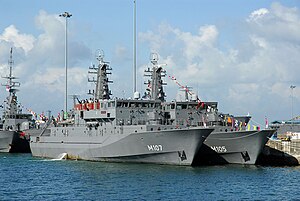Bedok class mine countermeasures vessel

Bedok-class MCMVs berthed at Changi Naval Base during the Navy Open House 2007
|
|
| Class overview | |
|---|---|
| Name: | Bedok |
| Builders: | Kockums, ST Engineering (Marine) |
| Operators: |
|
| Completed: | 4 |
| Active: | 4 |
| General characteristics | |
| Type: | Mine countermeasures vessel |
| Displacement: |
|
| Length: | 47.5 m (155 ft 10 in) |
| Beam: | 9.6 m (31 ft 6 in) |
| Draught: | 2.3 m (7 ft 7 in) |
| Installed power: | 4 × Saab-Scania DSI 14 diesel engines, each producing 1,440 bhp (1,070 kW) |
| Propulsion: |
|
| Speed: | 15 kn (28 km/h; 17 mph) |
| Range: | 2,000 nmi (3,700 km; 2,300 mi) at 12 kn (22 km/h; 14 mph) |
| Complement: | 33 (5 officers and 28 men) |
| Sensors and processing systems: |
|
| Armament: |
|
The Bedok-class are mine countermeasures vessels (MCMVs) of the Republic of Singapore Navy (RSN). They play an important role in the maritime security of Singapore, ensuring that the Singapore Strait and the sea lanes surrounding Singapore remain mine-free and open to international shipping. It is estimated that closure of Singapore's ports would result in direct trade losses amounting to more than US$1.2 billion daily, posing a serious threat to Singapore's economy. The four ships form the 194 Squadron of the RSN.
The RSN first acquired mine countermeasure capabilities in 1975, when the United States Navy's USS Whippoorwill and USS Thrasher were re-activated by the RSN's engineers and technicians in California. These Redwing-class Minesweepers were commissioned as RSS Jupiter and RSS Mercury respectively. RSS Jupiter was scrapped on 15 August 1986 and RSS Mercury was decommissioned on 31 March 1993. The need for modern minehunting vessels saw Singapore entering into an agreement with Sweden in 1991 to purchase four Landsort-class mine countermeasures vessels.
The ships were named after coastal areas in Singapore, and were selected from a name-the-ship contest held in 1993.
The ship's design incorporates a number of features important for mine countermeasures – low acoustic and magnetic signatures, as well as shock resistance to underwater explosions.
The Bedok class is made of glass-reinforced plastic, designed by the Swedish Navy and Kockums (then known as Karlskronavarvet). Its low magnetic and acoustic signatures reduces the possibility of setting off mines. It is highly durable, fire- and shock-resistant, easy to repair and is maintained only by painting. The ship's bridge, major combat equipment and engines are also shock-mounted to cushion against underwater explosions.
...
Wikipedia
